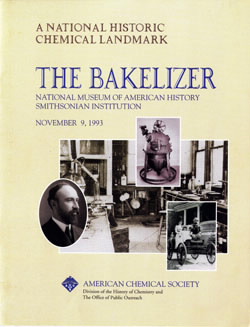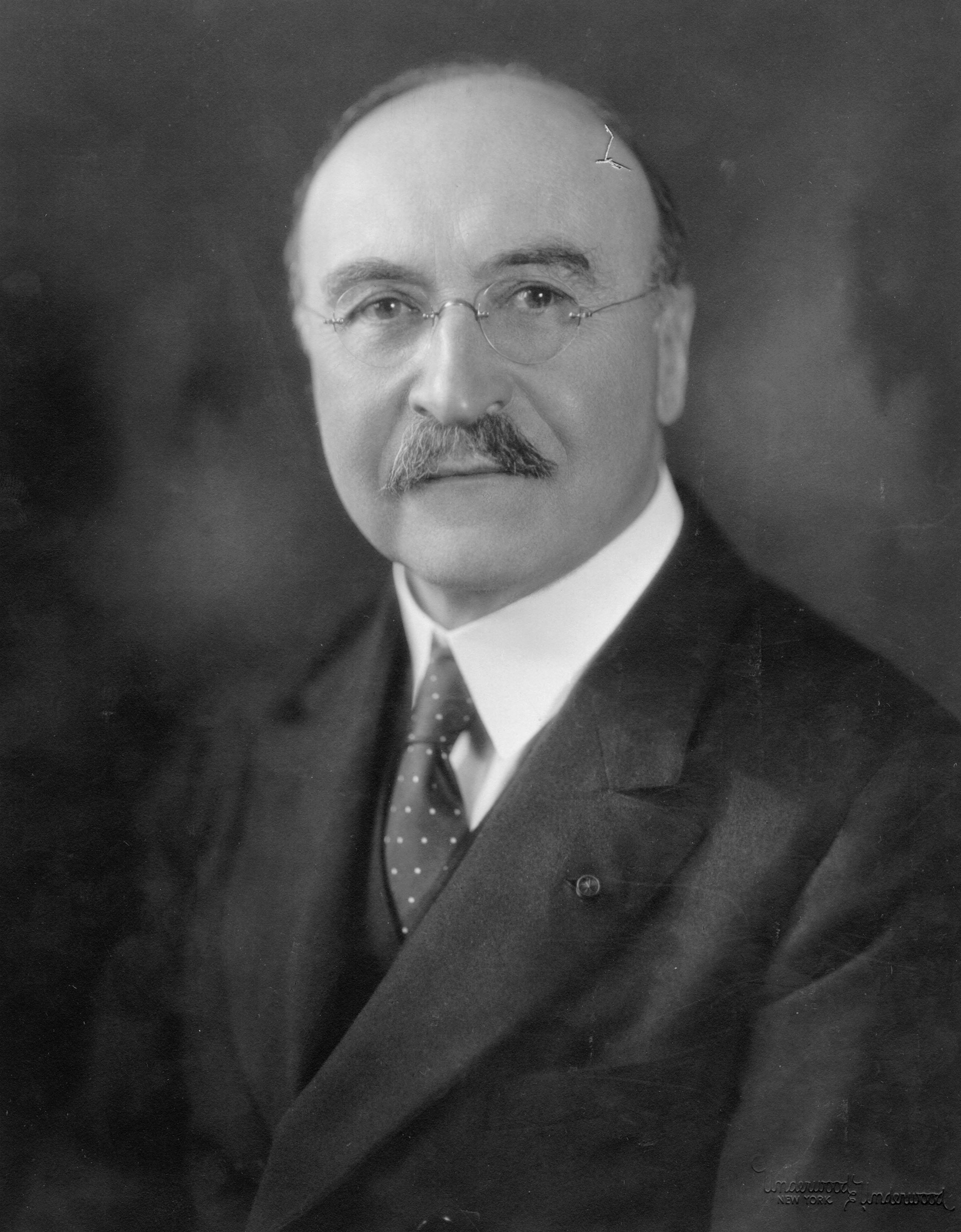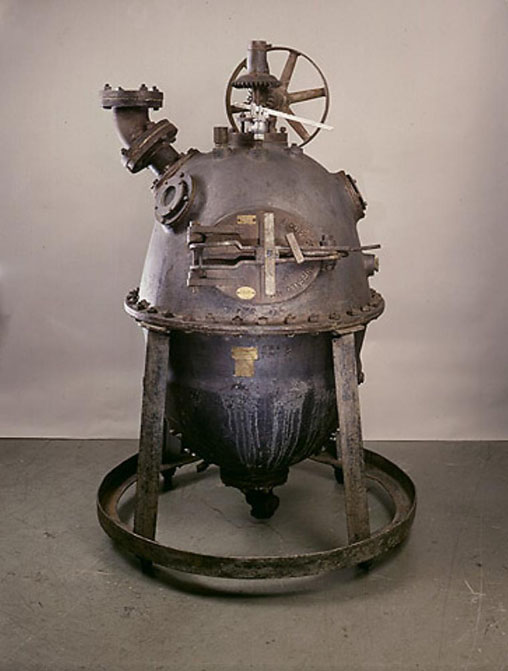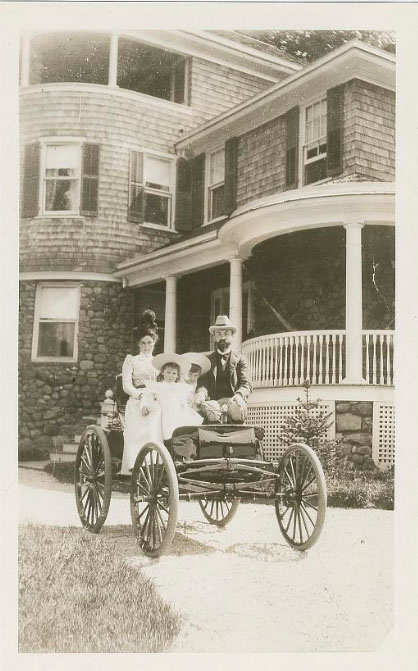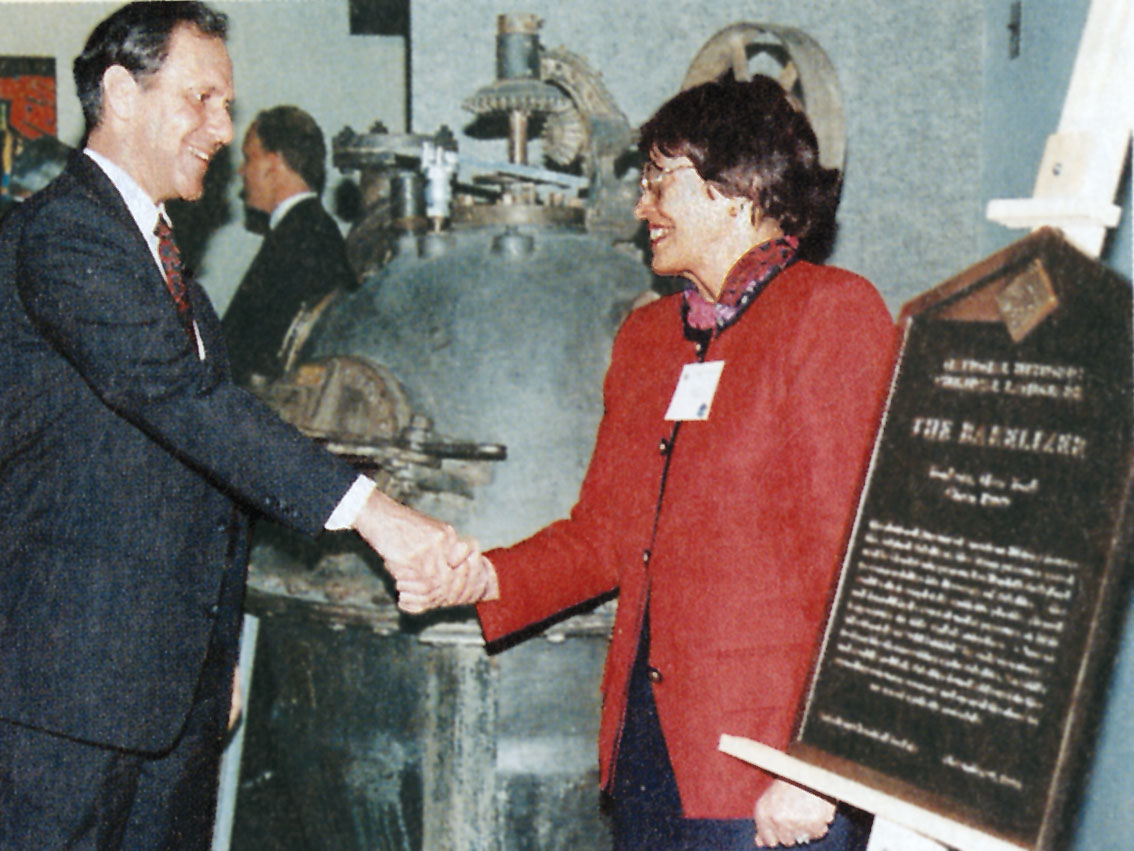Leo Hendrick Baekeland and the Invention of Bakelite®
Dedicated November 9, 1993, at the National Museum of American History in Washington, D.C.
History is shaped by the materials we develop and use. For thousands of years, humans used stone to fashion tools. Some 5,000 years ago, we learned how to make alloys of copper, and the Bronze Age began. Centuries later the Iron Age introduced iron as the material of choice. The introduction of Bakelite® the world’s first synthetic plastic—in 1907 marked the introduction of the Polymer Age.
Contents
Age of Polymers and Plastics
The Polymer Age is also called the Age of Plastics. "Plastic" (from the Greek "plastikos," meaning moldable) is the popular term for a variety of synthetic, or manmade, polymers. Polymers ("poly" = many) are very large molecules—veritable giants in the molecular world—comprised of smaller molecules called monomers ("mono" = one). Most polymers—but not all—consist of monomers that are similar to each other, joined together in a straight chain, like a long string of pearls.
Thousands of different polymers exist in nature. The most plentiful natural polymer in the world is cellulose, the major natural structural material of trees and other plants. The proteins that make up our bodies are polymers, including DNA (deoxyribonucleic acid), the material that carries the genetic codes for all living creatures.
Chemists did not fully understand or identify polymers until around 1900. But as early as 1861, the British chemist Thomas Graham had noted that when he dissolved organic compounds in solutions, some of them—cellulose, for instance—would not pass through even the finest filter paper without leaving sticky residues. Nor could these compounds be purified into a crystalline form. Dr. Graham thought such substances represented an entirely different organization of matter. He called them "colloids," after "kolla," the Greek word for glue, another material that could not penetrate fine filters.
Many 19th century manufacturers modified colloids and natural polymers to form new materials. In 1870, the American inventor John Wesley Hyatt used chemically modified cellulose to produce an astonishing new product called Celluloid, a plastic that was used for everything from hair combs to silent-movie film. By 1890, Count Hilaire de Chardonnet was marketing the first synthetic textile, Chardonnet silk, made by spinning strands of cellulose nitrate into artificial fiber.
These and other early plastics were made from existing materials. The next step—the creation of completely synthetic plastic—was still to come.
Man-made Polymers: Invention of Celluloid
During the Victorian era, it was fashionable for wealthy gentlemen to own a billiard table and a set of billiard balls crafted of the finest and most perfect ivory. But 19th century hunters had virtually decimated the elephant herds of Africa and India, the source of ivory. By 1863, the ivory shortage had become so critical that a New York billiard-ball manufacturer offered a $10,000 prize to the person who could create a useful substitute.
The winners were John Wesley Hyatt, a young printer in Albany, New York, and his brother, Isaiah. They never received the money. But they did change history — by inventing celluloid, one of the world's first plastics. Celluloid not only resembled ivory, it had astonishing properties: at normal temperatures, it was a permanent, hard solid; when heated, it became soft and could be molded or rolled into sheets. It soon became the material of choice for billiard balls and dozens of other products.
The Hyatts made celluloid by applying heat and pressure to a mix of cellulose nitrate and camphor; it was thus a plastic made by modifying natural materials. More than 40 years were to pass before the invention of the first wholly synthetic plastic.
Bakelite is a registered trademark, which is used for material based on the thermosetting phenol formaldehyde resin polyoxybenzylmethyl-englycolanhydride, developed in 1907-09 by Leo Baekeland.
Leo Baekeland and the Invention of Bakelite®
By 1899, the invention of Velox photographic paper had already made Leo Baekeland a wealthy man. At his Snug Rock estate in Yonkers, New York, he maintained a home laboratory where he and his assistant, Nathaniel Thurlow, involved themselves in a variety of projects.
Like other scientists of their day, Baekeland and Thurlow understood the potential of phenol-formaldehyde resins. The chemical literature included reports written decades earlier by the German chemist Adolf von Baeyer and by his student, Werner Kleeberg. Von Baeyer had reported that when he mixed phenol, a common disinfectant, with formaldehyde, it formed a hard, insoluble material that ruined his laboratory equipment, because once formed, it could not be removed. Kleeburg reported a similar experience, describing the substance he produced as a hard amorphous mass, infusible and insoluble and thus of little use.
In 1902, German chemist Adolf Luft patented a resin made by modifying Kleeburg's composition in the hope that it could compete commercially with celluloid. At least seven other scientists tried phenol and formaldehyde combinations in their attempt to create a commercially viable plastic molding compound. But no one was able to create a useful product.
Hoping to capitalize on shortages of naturally occurring shellac—used to insulate electrical cables in the early years of the 20th century—Baekeland and Thurlow, as well as several other investigators, were experimenting with soluble resins. (Shellac was made from a resin secreted by the East Asian lac bug; it was harvested by the labor-intensive process of scraping the hardened deposits from the trees these insects inhabited.) Eventually, they developed a phenol-formaldehyde shellac called Novolak, but it was not a commercial success. By the early summer of 1907, Baekeland changed his focus from trying to create a wood coating to trying to strengthen wood by actually impregnating it with a synthetic resin.
On June 18, 1907, Baekeland began a new laboratory notebook (now in the Archives Center of the Smithsonian's National Museum of American History) documenting the results of tests in which he applied a phenol and formaldehyde mixture to various pieces of wood. An entry made the following day states:
All these tests were conducted in concentrated horizontal digester and the apparatus was reasonably tight. Yet the surface of the blocks of wood does not feel hard although a small part of gum that has oozed out is very hard. I began to think that the formaldehyde evaporates before it can act and that the proper way would be to impregnate with the viscous liquid which is obtained by boiling CH2O+C6H5OH together without a catalytic agent. In order to determine in how far this is possible I have heated in sealed tubes a portion of this liquid so as to determine whether there is a further separation of H2O or whether this is simply a solution of the hard gum in excess of phenol, then by simple open air evaporation I shall be able to accomplish hardening while I shall not succeed in closed sealed tubes.
I have also heated an open tube rammed with a mixture of asbestos fiber and liquid.
Also a sealed tube rammed with mixture of asbestos fiber and liquid. Everything heated 4 hours at 140° C -159° C.
The notebook description of the last experiment of that day states:
Asbestos + A in sealed tube. I found tube broken perhaps in irregular expansion but the reactions seems to have been satisfactory because the resulting stick was very hard and below where there was some unmixed liquid A there was an end (?) of solidified matter yellowish and hard and entirely similar to the product obtained by simply heating A alone in sealed tube. This looks promising and it will be worth while to determine in how far this mass which I will call D is able to make moulded materials either alone or in conjunctions with other solid materials as for instance asbestos, casein, zinc oxid (sic), starch, different inorganic powders and lamp black and thus make a substitute for celluloid and for hard rubber.
A day later, Baekeland listed four different products, designated A, B, C, and D. Substance D was "insoluble in all solvents, does not soften. I call it Bakalite (sic) and it is obtained by heating A or B or C in closed vessels." Baekeland later decided that "C" and "D" were equivalent.
The key to reaching the final product "C" from "A" or "B" were machines that subjected earlier stages to heat and pressure. Baekeland called these machines "Bakelizers."
Baekeland made the first public announcement of his invention on February 8, 1909, in a lecture before the New York section of the American Chemical Society. Previous reactions had resulted in slow processes and brittle products, he said; then he continued "...by the use of small amounts of bases, I have succeeded in preparing a solid initial condensation product, the properties of which simplify enormously all molding operations..."
Baekeland's first patent in the field had been granted in 1906; in all, he took out more than 400 patents related to the manufacture and applications of Bakelite. He started semi-commercial production in his laboratory and, in 1910, when daily output had reached 180 liters, (most of it for electrical insulators), he formed a U.S. company to manufacture and market his new industrial material. By 1930, the Bakelite Corporation occupied a 128-acre plant at Bound Brook, New Jersey.
Properties and Uses of Bakelite
Bakelite can be molded, and in this regard was better than celluloid and also less expensive to make. Moreover, it could be molded very quickly, an enormous advantage in mass production processes where many identical units were produced one after the other. Bakelite is a thermosetting resin—that is, once molded, it retains its shape even if heated or subjected to various solvents.
Bakelite was also particularly suitable for the emerging electrical and automobile industries because of its extraordinarily high resistance (not only to electricity, but to heat and chemical action as well). It was soon used for all non-conducting parts of radios and other electrical devices, such as bases and sockets for light bulbs and electron tubes, supports for any type of electrical components, automobile distributor caps and other insulators.
Along with its electrical uses, molded Bakelite found a place in almost every area of modern life. From novelty jewelry and iron handles to telephones and washing-machines impellers, Bakelite was seen everywhere and was a constant presence in the technological infrastructure. The Bakelite Corporation adopted as its logo the mathematical symbol for infinity and the slogan, "The Material of a Thousand Uses," but they recognized no boundaries for their material.
The Achilles heel was color. The pure Bakelite resin was lovely amber, and it could take other colors as well. Unfortunately, it was quite brittle and had to be strengthened by "filling" with other substances, usually cellulose in the form of sawdust. After filling, all colors came out opaque at best and often dull and muddy. Ultimately, Bakelite was replaced by other plastics that shared its desirable qualities, but could also take bright colors.
Today, only one or two firms now make phenolic resins, but Baekeland's creation set the mold for the modern plastics industry.
Plastic: Material of Today
Today, synthetic plastics are everywhere. They are as familiar to us as wood or metal, and are easily taken for granted. Almost anyone can name a dozen familiar products made in part or in whole with plastic: toys, computers, clothing, sports equipment, carpet, appliances, building materials, signs, office supplies, packaging, phones and fashion accessories. But some are less visible: Medical equipment—from hip-joint replacements and pacemakers to contact lenses and surgical tools—are made using (wholly or partly) synthetic materials.
Dr. Baekeland's new material opened the door to the Age of Plastics and seeded the growth of a worldwide industry that today employs more than 60 million people. As the future unfolds, plastics and other synthetic polymers will play increasingly versatile roles in medicine, electronics, aerospace and advanced structural composites. New products will be manufactured and molded all over the world—in complex processes that began with Leo Baekeland, an idea, and the Bakelizer.
Biography of Leo Hendrick Baekeland (1863-1944)
Like many of the people who have made important contributions to American life, Leo Hendrik Baekeland was an immigrant. He was born in Belgium, in the Flemish city of Ghent, on November 14, 1863. His father, a cobbler, opposed his son's wish for an education and apprenticed him at age 13 to a shoemaker. Fortunately, Baekeland's mother, a domestic servant, insisted that he also be allowed to attend a government high school. It was there that Baekeland's lifelong commitment to chemistry began.
Soon young Leo had also enrolled in night classes in chemistry, mechanics and photography, paying his way by working as a pharmacist's assistant. In 1880, he used a city scholarship to enter the University of Ghent—the same university at which, only 15 years earlier, August Kekule had described the benzene ring, a discovery that became the cornerstone of modern organic chemistry.
Baekeland had a powerful mentor at Ghent, Kekule's former student, Theodore Swarts. Swarts guided Baekeland through his student years and beyond. By 1887, when the university appointed Baekeland assistant professor of chemistry, Swarts saw it as the start of an illustrious academic career. But Baekeland found himself less interested in pure chemistry than in its potential applications, and the two men often quarreled. Whether intentionally or not, Baekeland settled the argument for good a year later when, at 26, he married Swarts' daughter, Celine, and, two days afterward they left for the United States.
The newlyweds' trip to America was financed with a traveling fellowship he had received for academic study abroad. But Baekeland never returned to pure chemistry, or to his roots in Belgium. By 1897, he was a citizen of a new and exciting country, and a visible part of a fledgling chemical industry.
He settled in New York City, where the patronage of Columbia University professor Charles F. Chandler led him to a position at a local photographic supply company. This led in turn to his first major successful invention, Velox, a new type of photographic paper that would take images using artificial light. When George Eastman bought the rights to Velox in 1899, Baekeland became financially free to follow whatever scientific pursuits appealed to him.
Like most immigrants of his day, he wished to be wholly American. He named his son after George Washington, worked hard to overcome his Belgian accent, and—in his personal diaries, at least—expressed a firm belief that America and Americans were superior to all things European. His professional and personal enthusiasm varied widely. Scholars say his diaries show a man who was fascinated by the potential of chemistry, but unwilling to get mired down for long in any one project. He enjoyed his prosperity by buying two estates—one overlooking the Hudson, north of Yonkers, New York, and a second in Florida—and a yacht which he christened the "Ion." An avid motorist even before automobiles were safe, he toured Europe by car with his family as early as 1907 and spent hours tinkering with car motors. And he was a public man: In World War I, Baekeland was appointed to the Nitrate Supply Commission and served as president of the committee on patents of the National Research Council. He served as president of the American Institute of Chemical Engineers and the American Electrochemical Society and, in 1924, became the President of the American Chemical Society.
Leo Hendrik Baekeland's life spanned an era of remarkable discovery and development. Before his death in 1944, he had lived to see a panoply of new plastics and, with the advent of World War II, the explosive growth of the industry he had helped to establish.
Further Reading
- Bakelizer (National Museum of American History)
- Leo Henrick Baekeland Biography (Chemical Heritage Foundation)
Landmark Designation and Acknowledgments
Landmark Designation
The American Chemical Society designated Leo Hendrik Baekeland’s original Bakelizer as a National Historic Chemical Landmark at the National Museum of American History in Washington, D.C., on November 9, 1993. The plaque commemorating the invention reads:
The National Museum of American History houses the original Bakelizer, the steam pressure vessel used by chemist-entrepreneur Leo Hendrik Baekeland to commercialize his discovery of Bakelite - the world's first completely synthetic plastic. Phenol and formaldehyde reacted under pressure at high temperature in this sealed autoclave -known affectionately as 'Old Faithful' by early operators - to form the thermosetting resin Bakelite. Versatile and readily molded, Bakelite found wide use in the expanding consumer economy and opened the door to an era of synthetic materials.
Used by Baekeland around 1909, 'Old Faithful' was kept by the General Bakelite Corporation and its successor, Union Carbide Co., which donated it to the Smithsonian Institution in 1983. Constructed of iron alloys and still structurally sound, the Bakelizer is 35 inches wide, 40 inches deep, and nearly six feet tall.
Acknowledgments
Adapted for the internet from “The Bakelizer,” produced by the National Historic Chemical Landmarks program of the American Chemical Society in 1993.
Back to National Historic Chemical Landmarks Main Page.
Learn more: About the Landmarks Program.
Take action: Nominate a Landmark and Contact the NHCL Coordinator.

